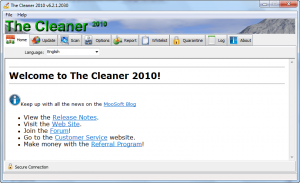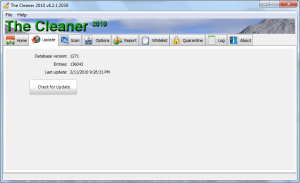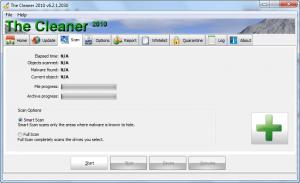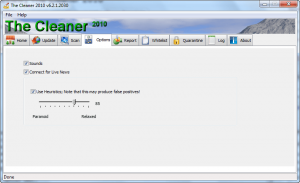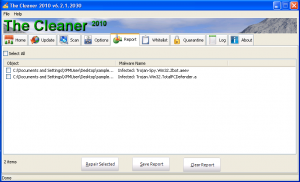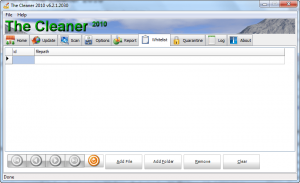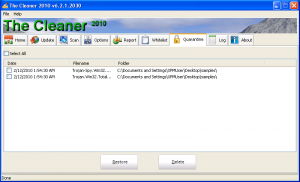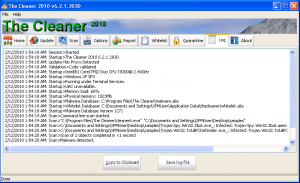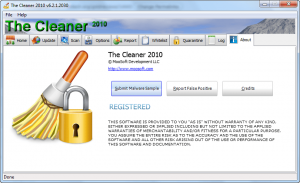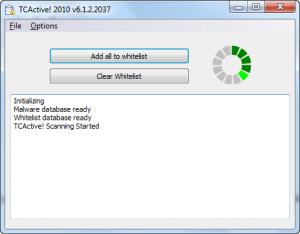{rw_text}Software reviewed in this article:
The Cleaner 2010 by MooSoft Development
Version reviewed:
v6.1.2030
Supported OS:
Windows2K/XP/Vista/Windows7/Server 32bit and 64bit
Price:
$19.95 (USD) for one year subscription but you can get it for free for a limited time at Giveawayoftheday.com!
Software description as per the developer:
MooSoft’s The Cleaner is a high performance application that protects, prevents and recovers your computer from malicious software (malware) attacks, including: trojans, spyware, adware and other harmful programs.
The Cleaner detects and removes malware that is often missed by anti-virus software. It delivers one of the quickest and most thorough scans on the market. It will scan your computer in under eight minutes making it an excellent addition to your computer’s defenses. The Cleaner has been in development for twelve years and is used in over 130 countries.
————————-{/rw_text} –>
{rw_good}
- Protects users against spyware, adware, trojans, rootkits, etc. – everything that isn’t a virus.
- Allows users to define a “whitelist” to prevent false readings on software that user knows for sure are clean.
- Has real-time protection.
- Works fairly well side-by-side with other security software.
{/rw_good} –>
{rw_bad}
- Doesn’t provide much “value for the money” when compared to rival software.
{/rw_bad} –>
{rw_score}
{for=”Ease of Use” value=”10″}Very easy to use.
{/for}
{for=”Performance” value=”6″}Scans are done quicker than many other anti-spyware/anti-virus/anti-malware I have used and computer resource usage during scans is actually fairly low. However, the TCActive continually uses ~10% CPU while sitting idle in the background. Furthermore, detection rates can be improved.
{/for}
{for=”Usefulness” value=”9″}Most people wouldn’t mind some “extra” protection.
{/for}
{for=”Price” value=”5″}Being only anti-spyware, $19.95 per year is hardly worth it considering other rival software – that offer more protection – are cheaper.
{/for}
{for=”Arbitrary Equalizer” value=”6″}This category reflects an arbitrary number that does not specifically stand for anything. Rather this number is used to reflect dotTech’s overall rating/verdict of the program in which all the features and alternatives have been considered.
{/for}
{/rw_score} –>
{rw_verdict}[tdown]
{/rw_verdict} –>
The Cleaner is a veteran in the field of computer protection. Supposedly, it was created back in 1998 claiming the title as “the first malware remove program on the market” and to “counter the Back Orifice trojan”. So, with such strong history, you may ask, why have you never heard of The Cleaner before (assuming you never heard of it… I didn’t before today)? Well probably because it is one of the only “sidekick” security software that charges a yearly subscription and yet does not even protect you against all malware. According to the developer, The Cleaner protects users against “spyware, adware, trojans, rootkits, etc… everything that isn’t a virus”.
The Cleaner actually consists of two parts: TCActive! and The Cleaner. TCActive! is The Cleaner’s real-time protection software. The Cleaner is, well, the main program itself. This is what the main program window of The Cleaner looks like:
Using The Cleaner is fairly self explanatory and stereotypical of anti-malware software. From the “Update” tab…
…you can manually update the signature database. From the “Scan” tab…
…you can manually run an on-demand scan. Three types of scans are available: “smart”, “full”, and scans on individual files you select. Unless you are on Vista/Win7 and have UAC enabled, you can drag + drop files onto that green plus to scan them. If you are on Vista/Win7 with UAC enabled, the drag + drop does not work (it is a known issue – the developer is aware of it) so you must use the right-click context menu entry to scan individual files. I do wish the developer adds some way to simply browse for files to scan in case someone does not want to drag + drop (or can’t drag + drop) or use the context menu entry.
The “Options” tab…
…gives you the option to change a few settings. For those that don’t know “heuristics” are another method – other than signature detection – to detect malware. If you disable heuristics, you can still use The Cleaner (it will only use the signature database then) but you will be less protected..
The “Report” tab is where you are shown the results of your scans are displayed:
With any detections found, you are given the option to remove them. You can also add files from the “Report” to the whitelist (right click on them and select “Add to Whitelist”). Take note that any files you select to “repair” are quarantined and not deleted.
The “Whitelist” tab shows the files you have added to your whitelist:
Any files that you have added to the whitelist will be, essentially, marked as “safe” by The Cleaner.
The “Quarantine” tab shows all the files you have “repaired”:
Once a file is placed in quarantine, you then have the option to delete it (or un-quarantine it).
The “Log” tab displays the skeleton log The Cleaner keeps:
Lastly, the “About” tab simply gives some information about The Cleaner, and allows the user to report false positives and submit malware samples:
In terms of TCActive!, there isn’t much for you to do with it except turn it on and let it do its thing. It does have a program window to it…
…but aside from adding all running processes to the whitelist and viewing the log, there isn’t much to do.
Two special things to note about The Cleaner:
- Although it does not protect against all malware (as mentioned earlier, it protects against everything but viruses), the signature database it has is fairly large: 130,000+ entries. Of course a large database does not mean an effective detection rate, but it does mean the developer spends a good amount of time adding to the database.
- TCActive! does not work like most other live protection. Most live protection you will encounter monitor pretty much everything on your computer, so if you so much as download a bad file the live protection should detect it and let you know. TCActive!, on the other hand, does not work like this. With TCActive! running you can download as many malicious files as you want and TCActive! won’t say a word until and unless you run the files and they try to make changes to your computer. If The Cleaner was a “main” security software as opposed to a “sidekick” this would be a huge con. However, since The Cleaner is a “sidekick” this behavior actually benefits it because it helps minimize the clash between the live protection of The Cleaner and other running security software, and therefore makes The Cleaner more compatible with any other anti-malware you may be running.
In terms of performance, The Cleaner is good and bad (for the lack of a better term). On-demand scans are actually done at a fairly good pace – faster than many other anti-malwares I have used (it took me ~45 mins to do a full scan my computer which is not bad considering I have 100+ GB filled). Computer resource usage was actually fairly low during the on-demand scan too: ~10-20% CPU and ~10-20 MB of RAM. Computer resource usage of TCActive!, though, is disappointing. As I already explained, TCActive! is The Cleaner’s live protection so – unless you opt to turn it off – will be on all the time. While it is on, TCActive! is constantly using ~10% CPU. This is really not desirable and should be improved. (It also uses ~2 MB of RAM but that isn’t that bad so I can’t complain about that.) Detection rates of The Cleaner are also an area that can be improved.
To test out how well The Cleaner works in detecting malware, I downloaded and used a ~6500 malware test sample. Now let me be clear that this sample also contained viruses – viruses that The Cleaner is not able to detect and the developer is clear about this – so one must give The Cleaner some elbow room for not being able to detect all the malware. However, even taking into account that some of the non-detected malware are viruses, The Cleaner still performed fairly poorly: it detected ~400 malware out of ~6500.
In addition to testing The Cleaner, I tested out a few other security software to see how they did as compared to The Cleaner. SUPERAntiSpyware was a disappointment also, detecting ~400. While Malwarebytes detected a lot more than The Cleaner (~1500), Malwarebytes was also a disappointment considering Malwarebytes is a full anti-malware, protecting against everything The Cleaner does and against viruses. SpywareTerminator, on the other hand, was a pleasant surprise; it detected ~1500. Sure ~1500 is not a lot considering there were ~6500, but ~1500 is more than what The Cleaner and SUPERAntiSpyware detected, and equal to what Malwarebytes detected. Put that into context that SpywareTerminator is not an anti-virus (you have the option to using ClamAV with it but I declined) – it is anti-spyware just like TheCleaner and SUPERAntiSpyware and you understand why I was surprised at these results from SpywareTerminator.
What didn’t surprise me is the fact that Avira, avast!, and a-squared outperformed all the others by detecting most all of the malware test sample. (Keep in mind Avira, avast!, and a-squared are anti-virus and anti-spyware, and they are “main” security software as opposed to the other others which are “sidekicks”.)
Now I would like to emphasis the point that my detection tests were only done with on-demand scanning, and they were not done methodically enough to be published in Computer Science Today. What I am trying to say is I used my tests to give me a general ballpark idea as to which software performs how well; these tests were not conducted in an extremely controlled environment with a huge sample size and are not to be taken as seriously as you would take AV-Comparatives.org results. As I said, the tests are just intended to give a general idea of which security software stands where (which is also why I was not as specific as I could have been on the detection rates/numbers). In that regard, I must say The Cleaner has been marked off my list of potential security software to use on my computer, and I suggest you do the same. I say this because The Cleaner just doesn’t fair very well when compared to the competition.
First of all, The Cleaner has a $19.95 yearly subscription (if you want “updates” as per the developer’s website). Most other “sidekick” software (SUPERAntiSpyware, Malwarebytes, SpywareTerminator, and others) can be had for a one-time payment ranging from $20-$30, while others are even free. These other “sidekick” software performed better than The Cleaner, and cost less. So why would one shell out $20 a year for something inferior when they can get someone superior for cheaper?
This review was conducted on a laptop running Windows 7 Professional 32-bit. The specs of the laptop are as follows: 3GB of RAM, a Radeon HD 2600 512MB graphics card, and an Intel T8300 2.4GHz Core 2 Duo processor.
{rw_freea}
For free alternatives, please read my article on free security software.
{/rw_freea} –>
{rw_verdict2}The Cleaner may be a veteran, but I am not impressed; thumbs down. If you are looking for effective protection for your computer, consider paying for Nod32, Kaspersky, Norton, Avira Premium, avast! Pro, or a number of other good security software (see AV-Comparatives.org for excellent security software tests). If you want effective protection for your computer, but don’t want to pay a dime, please read my article on free security software.
{/rw_verdict2} –>

 Email article
Email article
